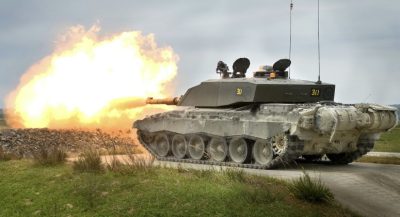Britain Sending Depleted Uranium Rounds to Ukraine: Greatest Escalation Yet Pushes Very Close to Russia’s Nuclear Red Lines

All Global Research articles can be read in 51 languages by activating the Translate Website button below the author’s name.
To receive Global Research’s Daily Newsletter (selected articles), click here.
Follow us on Instagram and Twitter and subscribe to our Telegram Channel. Feel free to repost and share widely Global Research articles.
***
British Minister of State for Defence Annabel Goldie announced on March 20 that her country would supply Ukraine with depleted uranium munitions as part of an aid package to bolster the Eastern European state’s ongoing war effort against Russia. The munitions would be supplied alongside Challenger 2 tanks, of which Britain pledged to send 14 in January, with the majority of training for Ukrainian personnel having been completed since. The pledge to send Challenger 2s made Britain the first country to offer Western designed tanks to Kiev, with Germany under significant U.S. and Polish pressure subsequently granting permission to supply Leopard 2 tanks, widely used across Europe, to Ukraine as well.
When asked specifically whether depleted uranium weapons munitions would be supplied, Goldie replied: “Alongside our granting of a squadron of Challenger 2 main battle tanks to Ukraine, we will be providing ammunition including armour piercing rounds which contain depleted uranium. Such rounds are highly effective in defeating modern tanks and armoured vehicles.” The munitions most likely being referred to are the L26A1 and L27A1, which are compatible with British rifled tank guns. The Challenger 2s were reported in January to be scheduled for delivery by the end of March, meaning the first use of depleted uranium rounds against Russian forces could well be imminent depending on how ready Ukrainian crews are to quickly begin frontline operations.

British Army Challenger 2 Tank
The possible supply of depleted uranium weapons has long been a highly controversial issue, with the head of the Russian delegation to the Vienna Negotiations on Military Security and Arms Control Konstantin Gavrilov having thus cautioned on January 25: “We know that Leopard 2 tanks, as well as Bradley and Marauder armoured fighting vehicles, can use depleted uranium shells, which can contaminate terrain, just like it happened in Yugoslavia and Iraq. If Kiev were to be supplied with such munitions for the use in western heavy military hardware, we would regard it as the use of ‘dirty nuclear bombs’ against Russia, with all the consequences that entails.” Regarding the possible responses Russia could take, Gavrilov elaborated: “If Washington and NATO countries provide Kiev with weapons for striking against the cities deep inside the Russian territory and for attempting to seize our constitutionally affirmed territories, it would force Moscow to undertake harsh retaliatory actions. Do not say that we did not warn you.” A number of analysts took this to be an implied threat of a Russian nuclear response.
It remains highly possible that Britain is seeking to set a precedent that would pave the way to the U.S. and Germany providing depleted uranium arms for their own tanks which they are set to supply to Ukraine, as London alongside Warsaw and the three Baltic States has consistently been far less cautious in what armaments are supplied to the front. Depleted uranium is among the heaviest elements on the planet, and is produced using low-level radioactive waste left over from the manufacture of nuclear fuel or nuclear warheads which makes it affordable to produce in large quantities. It is widely used in Western anti armour rounds to provide a greater penetrative capability – a notable example is the M829 armour fin-stabilised discarding sabot round which is compatible with the M1 Abrams and Leopard 2. Using such rounds can have calamitous environmental impacts, emitting highly toxic radioactive particles emitted into the air spreading for well over 40km as easily inhalable dust and having half-lives of over four billion years.

M1 Abrams Tank Firing
The effects of depleted uranium use were seen in the Gulf War, with British Royal Navy Commander Robert Green reporting: “a surge of unexplained illnesses, cancers and children born with genetic deformities among the Iraqi people, especially in the south near the battlefields.” A confidential UN report leaked in May 1999 similarly concluded regarding depleted uranium weapons: “this type of ammunition is nuclear waste, and its use is very dangerous and harmful.” In the subsequent Iraq War the following decade the city of Fallujah was particularly heavily bombarded by depleted uranium weapons by U.S. forces, with Professor Chris Busby, one of the authors of a survey of 4,800 Fallujah residents, writing regarding the connection between these attacks and the rapid increase in cancers and birth defects that followed: “to produce an effect like this, some very major mutagenic exposure must have occurred in 2004 when the attacks happened.” He concluded that some kind of uranium weapon had to have been the cause.
The Fallujah survey by 11 experts covering over 700 households, concluded that the effects on the population were “similar to that in the Hiroshima survivors who were exposed to ionising radiation from the bomb and uranium in the fallout.” Depleted uranium weapons were found to have had highly similar effects on populations in Yugoslavia, which was heavily bombarded by NATO forces in 1999. With much of the fighting in the Russian-Ukrainian War taking place on territory Russia considers as its own, the use of depleted uranium weapons particularly against population centres, which would place the Russian speaking civilians there at tremendous risk, could lead to an unprecedentedly harsh response by Moscow potentially take the country to the brink escalation using nuclear assets of its own.
*
Note to readers: Please click the share buttons above. Follow us on Instagram and Twitter and subscribe to our Telegram Channel. Feel free to repost and share widely Global Research articles.
Featured image: British Challenger 2 Tank (All images in this article are from MWM)

